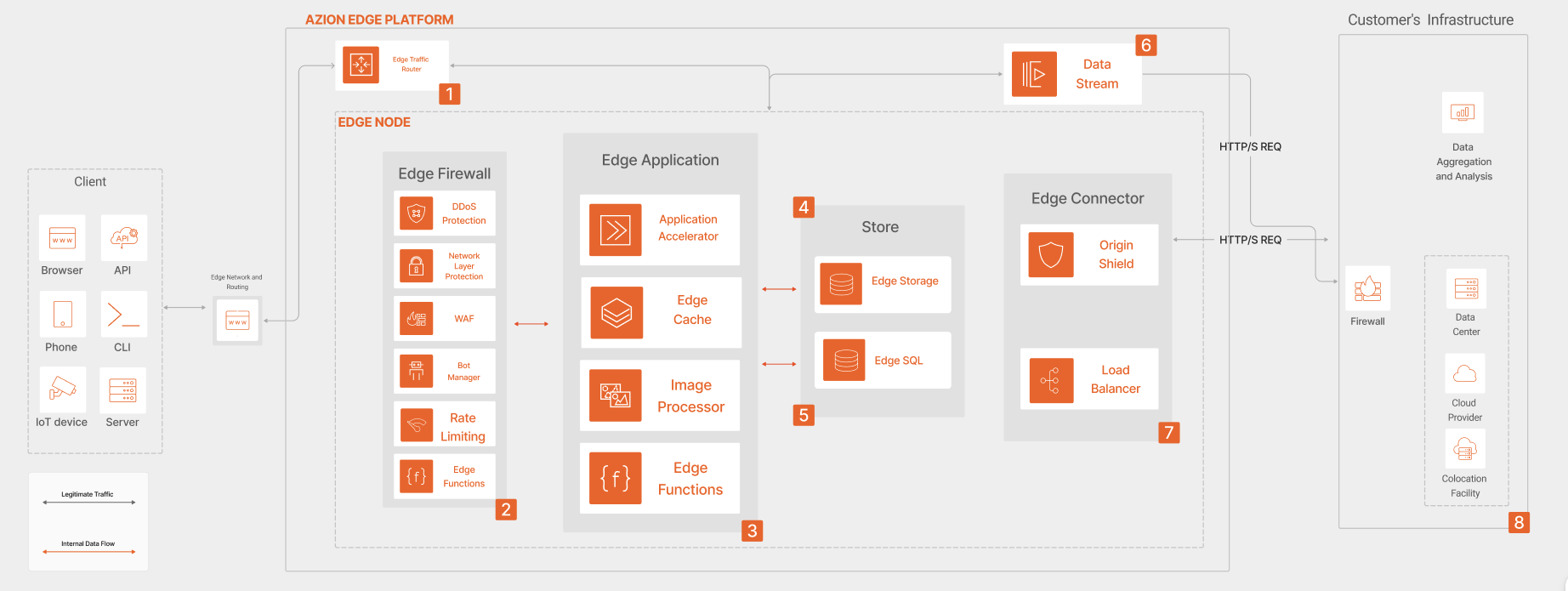Accelerate Application Modernization at the Edge
At Azion, application modernization is a transformative process that upgrades legacy applications to align with the dynamic demands of modern business environments. It’s implemented using a serverless approach and microservices architecture on an edge infrastructure, architecting your system for operational simplicity, faster deployment, and scalability.
Azion optimizes performance by processing data closer to its source, drastically reducing latency and improving user experience. The serverless model cuts costs by eliminating server management and DevOps workflows, facilitating overall business efficiency, competitiveness, and new strategies adoption.
Your application can be completely hosted at Azion, but there’s the possibility of having only parts of the system running at the edge. This possibility helps the migration of legacy applications to modern edge applications, as you can perform this piece by piece, adapting everything and testing to ensure it meets your needs.
Architecture

Dataflow
-
The user accesses the Domain related to the Edge Application being accessed. This request goes to Azion Traffic Router, which chooses the optimal Edge Node to receive the request and directs the request to this Edge Node.
-
The request goes through Edge Firewall and is analyzed. If it’s not a malicious request, it reaches the Edge Application.
-
The request reaches the edge application and based on its Rules Engine configuration, accesses the requested content. If configured, Image Processor, Edge Cache, Application Accelerator, and Edge Functions will be executed. With Edge Functions, you can have the logic performed at the edge, improving the usability and maintainability of decentralized applications. These functions are written in Javascript and run on Azion Runtime.
-
The content, if static, will be stored in Edge Storage. So, it’ll be requested and returned as a response.
-
Operations requiring database transactions can be accomplished with Edge SQL.
-
The application’s logs are sent through Data Stream and can be analyzed by the customer.
-
If it’s necessary to access an origin outside Azion:
- Activating Origin Shield, your application is protected from a network list maintained by Azion.
- Activating the Load Balancer module balances traffic across your origins, data centers, or cloud providers and mitigates network congestion and server overload.
After all this process, the application returns a response to the request.
Components
- Edge Application: set up an edge application to configure delivery and cache policies, create rules to automate cache policy assignments based on content type, and determine how content is cached.
- Edge Cache: global module to cache content at the edge.
- Edge Functions: allows you to create event-driven, serverless applications, at the edge of the network, closer to users.
- Rules Engine: a tool to configure the scenarios in which a specific cache policy is enforced.
- Tiered Cache: module that creates an additional cache layer between the edge and your origin servers, reducing latency and infrastructure costs.
- Load Balancer: module designed to balance traffic across your origins, data centers, or cloud providers, mitigating network congestion and server overload.
- Edge Storage: a scalable and secure storage service designed to integrate object storage with the Azion Web Platform using the S3 standard for object operations.
- Origins: allows you to customize the source address of your Edge Application content, the Host header of your application, the path, and the HMAC authentication credentials for protected services.
- Domains: register a custom domain with Azion to deliver the edge application.
- Azion Marketplace is a digital catalog that makes it easy to find, test, and deploy edge-running software.
- Azion CLI: an open-source command-line interface (CLI) that lets you interact with Azion Web Platform using a terminal.
- Azion Console: Azion’s configuration interface where you can access all the available products and their settings. It enables you to complete all tasks in Azion’s platform
Implementation
- Create an edge application:
- Create a domain and associate it with the edge application:
- On Console, create a domain using the + Create button on the homepage.
- Use the Azion API to create a domain.
- If you created an application through a template, the domain is created for you.
- Point domain to Azion: update your DNS settings to point your domain’s CNAME record to the Azion CDN endpoint provided for your domain. This step isn’t mandatory.
- Test and monitor your edge application.